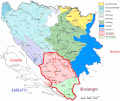Portal:Lakes
The Lakes Portal
A portal dedicated to Lakes
Introduction

A lake is an often naturally occurring, relatively large and fixed body of water on or near the Earth's surface. It is localized in a basin or interconnected basins surrounded by dry land. Lakes lie completely on land and are separate from the ocean, although they may be connected with the ocean by rivers. Most lakes are freshwater and account for almost all the world's surface freshwater, but some are salt lakes with salinities even higher than that of seawater. Lakes vary significantly in surface area and volume of water.
Lakes are typically larger and deeper than ponds, which are also water-filled basins on land, although there are no official definitions or scientific criteria distinguishing the two. Lakes are also distinct from lagoons, which are generally shallow tidal pools dammed by sandbars or other material at coastal regions of oceans or large lakes. Most lakes are fed by springs, and both fed and drained by creeks and rivers, but some lakes are endorheic without any outflow, while volcanic lakes are filled directly by precipitation runoffs and do not have any inflow streams.
Natural lakes are generally found in mountainous areas (i.e. alpine lakes), dormant volcanic craters, rift zones and areas with ongoing glaciation. Other lakes are found in depressed landforms or along the courses of mature rivers, where a river channel has widened over a basin formed by eroded floodplains and wetlands. Some lakes are found in caverns underground. Some parts of the world have many lakes formed by the chaotic drainage patterns left over from the last ice age. All lakes are temporary over long periods of time, as they will slowly fill in with sediments or spill out of the basin containing them. (Full article...)
Selected article -
Llanishen Reservoir (Welsh: Cronfa Ddŵr Llanisien) is a Victorian reservoir in north Cardiff, Wales. The reservoir is one of the reservoirs constructed as part of the Taff Fawr scheme for supplying water to Cardiff and was completed in 1886. It forms part of the Nant Fawr Corridor from the top of Roath Park to the countryside beyond Cyncoed.
The reservoir was used for water supply until the mid-1970s when it became redundant. It was then used for leisure activities and for 'topping up' the adjacent Lisvane Reservoir until it was drained completely. After buying Hyder plc, its new owner Western Power Distribution (WPD), proposed to redevelop the reservoir site, but after a series of objections from national governing bodies, the County Council, local residents and both local and national politicians this was blocked. On 30 August 2013 WPD sold both Llanishen and Lisvane reservoirs to CELSA Group.
In January 2016, Welsh Water acquired both Llanishen and Lisvane reservoirs from CELSA Group on a 999-year lease, which allows Welsh Water to use both reservoirs for water supply and recreational purposes while also allowing CELSA UK to continue to take its water supply from the Lisvane reservoir. (Full article...)
General topics
| Lake zones |
|---|
| Lake stratification |
| Lake types |
| See also |
Need assistance?

Do you have a question about lakes that you can't find the answer to? Consider asking it at the Wikipedia reference desk.
Categories
More articles
Associated Wikimedia
The following Wikimedia Foundation sister projects provide more on this subject:
-
Commons
Free media repository -
Wikibooks
Free textbooks and manuals -
Wikidata
Free knowledge base -
Wikinews
Free-content news -
Wikiquote
Collection of quotations -
Wikisource
Free-content library -
Wikiversity
Free learning tools -
Wiktionary
Dictionary and thesaurus
External media

- World Lake Database. International Lake Environment Committee Foundation. – provides a searchable database
- Global Lakes and Wetlands Database. World Wide Fund for Nature. – available for free download
































































